| dc.contributor.advisor | Ismail, Ahmed | |
| dc.contributor.author | Abbasi, Salman | |
| dc.date.accessioned | 2023-04-05T16:20:41Z | |
| dc.date.available | 2023-04-05T16:20:41Z | |
| dc.date.issued | 2022-07 | |
| dc.identifier.uri | https://hdl.handle.net/11244/337256 | |
| dc.description.abstract | Seismic data is often contaminated with noise that must be attenuated before making reliable seismic interpretations. Seismic noise can be either random noise, which cannot be correlated between seismograms, or coherent noise, which shows patterns in the seismic gathers. Seismic multiples and ground rolls are good examples of coherent noise. My research focuses on optimizing some existing methods for multiples attenuation. My first project focused on optimizing the Radon Transform method to better attenuate seismic multiples. The Radon Transform method entails applying Normal Move Out (NMO) to the seismic Common Depth Point (CDP) gathers using the velocities of the primary signals to remove travel time delay with increasing offset and flatten seismic events. The NMO corrected CDP gathers are transformed to radon domain (intercept time (τ) – curvature (q)), where different seismic multiples and primaries are separated based on their curvatures. In the (τ –q) domain, NMO corrected CDP using primaries velocities depicts near zero curvature for primaries and positive curvatures for multiples. However, using primaries velocities for NMO often results in less distinction between primaries and multiples based on their move out in the (τ –q) domain. Thus, I used the intermediate velocities between primaries and multiples for the NMO correction of the CDP gathers input to the τ-q domain, which resulted in a more significant separation between multiples and primaries and improved multiples removal in the τ-q domain. The results showed better multiples removal as compared to using the conventional velocity radon, where CDP gathers are NMO corrected using the primaries velocities. Although applying multiples velocities seem to render more primaries-multiples move out, testing this method on more synthetic and real seismic gathers showed mixing of the primaries and multiples energy at the near offsets in the radon space. Thus, my second project used coherency as the foundation for attenuating multiples. I used the multiples velocities for NMO correction and the singular value decomposition (SVD) for attenuating multiples in the time domain. Using multiples velocity, the NMO flattened coherent multiples attributed to dominant principal components and can be separated from the unflatten primaries. Principal components attributing to multiples are selected and composed back to seismic traces. The selected multiples are then removed from the original data using simple subtraction. Results of multiples attenuation using Radon Transform and principal components methods were compared. The principal components method seemed to be more effective in multiples attenuation. This may be due to the principal component method improves the separation between flattened multiples and primaries and does not require data transformation to another domain, which often produces artifacts. Both methods opt for an unconventional velocity selection approach, resulting in enhanced performance of the parabolic radon and principal components methods for attenuating seismic multiples. | |
| dc.format | application/pdf | |
| dc.language | en_US | |
| dc.rights | Copyright is held by the author who has granted the Oklahoma State University Library the non-exclusive right to share this material in its institutional repository. Contact Digital Library Services at lib-dls@okstate.edu or 405-744-9161 for the permission policy on the use, reproduction or distribution of this material. | |
| dc.title | Seismic multiples attenuating using Radon Transform and principal components | |
| dc.contributor.committeeMember | Abdelsalam, Mohamed | |
| dc.contributor.committeeMember | Davila, Lao | |
| dc.contributor.committeeMember | Sabit, Ekin | |
| osu.filename | Abbasi_okstate_0664D_17802.pdf | |
| osu.accesstype | Open Access | |
| dc.type.genre | Dissertation | |
| dc.type.material | Text | |
| dc.subject.keywords | denoising | |
| dc.subject.keywords | multiples | |
| dc.subject.keywords | rank reduction | |
| dc.subject.keywords | seisimic | |
| thesis.degree.discipline | Geology | |
| thesis.degree.grantor | Oklahoma State University | |
